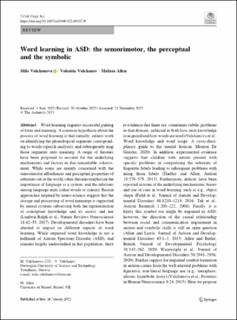| dc.description.abstract | Word learning requires successful pairing of form and meaning. A common hypothesis about the process of word learning is that initially, infants work on identifying the phonological segments corresponding to words (speech analysis), and subsequently map those segments onto meaning. A range of theories have been proposed to account for the underlying mechanisms and factors in this remarkable achievement. While some are mainly concerned with the sensorimotor affordances and perceptual properties of referents out in the world, other theories emphasize the importance of language as a system, and the relations among language units (other words or syntax). Recent approaches inspired by neuro-science suggest that the storage and processing of word meanings is supported by neural systems subserving both the representation of conceptual knowledge and its access and use (Lambon Ralph et al., Nature Reviews Neuroscience 18:42–55, 2017). Developmental disorders have been attested to impact on different aspects of word learning. While impaired word knowledge is not a hallmark of Autism Spectrum Disorder (ASD), and remains largely understudied in this population, there is evidence that there are, sometimes subtle, problems in that domain, reflected in both how such knowledge is acquired and how words are used (Vulchanova et al., Word knowledge and word usage: A cross-disciplinary guide to the mental lexicon, Mouton De Gruyter, 2020). In addition, experimental evidence suggests that children with autism present with specific problems in categorizing the referents of linguistic labels leading to subsequent problems with using those labels (Hartley and Allen, Autism 19:570–579, 2015). Furthermore, deficits have been reported in some of the underlying mechanisms, biases and use of cues in word learning, such as e.g., object shape (Field et al., Journal of Autism and Developmental Disorders 46:1210–1219, 2016; Tek et al., Autism Research 1:208–222, 2008). Finally, it is likely that symbol use might be impaired in ASD, however, the direction of the causal relationship between social and communication impairment in autism and symbolic skills is still an open question (Allen and Lewis, Journal of Autism and Developmental Disorders 45:1–3, 2015; Allen and Butler, British Journal of Developmental Psychology 38:345–362, 2020; Wainwright et al., Journal of Autism and Developmental Disorders 50:2941–2956, 2020). Further support for impaired symbol formation in autism comes from the well-attested problems with figurative, non-literal language use (e.g., metaphors, idioms, hyperbole, irony) (Vulchanova et al., Frontiers in Human Neuroscience 9:24, 2015). Here we propose that embodied theories of cognition which link perceptual experience with conceptual knowledge (see Eigsti, Frontiers in Psychology 4:224, 2013; Klin et al., Philosophical Transactions of the Royal Society of London. Series B: Biological Sciences 358:345–360, 2003) might be useful in explaining the difficulty in symbolic understanding that individuals with autism face during the word learning process. | en_US |

